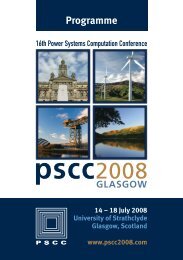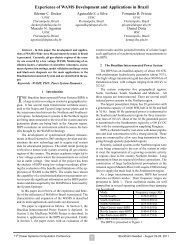Excitation Control System Design of Superconducting ... - PSCC
Excitation Control System Design of Superconducting ... - PSCC
Excitation Control System Design of Superconducting ... - PSCC
You also want an ePaper? Increase the reach of your titles
YUMPU automatically turns print PDFs into web optimized ePapers that Google loves.
cases 3 and 4, reactive power control is involved in<br />
improving system stability. It is clearly seen from Fig<br />
10, that the excitation power rises up to around 0.2<br />
[p.u.] and then back to around -0.1 [p.u.] in case 4,<br />
which reflects much power to absorb (inject) from (to)<br />
the system at SCG node, mostly from (to) SCG; it<br />
results in increase (decrease) <strong>of</strong> output power.<br />
<strong>Excitation</strong> power in case 3 goes up to the same level as<br />
case 4, but less stability improvement is obtained. This<br />
shows that SMES effect contribute to transient stability<br />
improvement. From Fig.11, the first swing <strong>of</strong> terminal<br />
voltage in case 4 is higher than other cases due to the<br />
PSS output signal; however, it is reduced and the<br />
oscillation <strong>of</strong> terminal voltage is improved well in case<br />
5 from the effect <strong>of</strong> reactive power control.<br />
In order to assess the performance <strong>of</strong> the excitation<br />
control system, an index as shown in (21) is introduced;<br />
it is the total curve area <strong>of</strong> variables with respect to the<br />
reference values in all generators in a system.<br />
AREA ∑ ∫ X −X<br />
dt (21)<br />
=<br />
g∈G T<br />
g<br />
g0<br />
where Xg is the considered variable, Xg0 is the steady<br />
state value <strong>of</strong> considered variable, G is the set <strong>of</strong><br />
generators, and T is the period <strong>of</strong> time.<br />
Here, the rotor angle difference <strong>of</strong> each generator is<br />
considered as the variables for assessment and T is set<br />
to be 10 sec. In addition to the previous simulation,<br />
other fault contingencies are also considered for each<br />
pattern <strong>of</strong> SCG installation, which are 3LG faults at<br />
nodes 43, 45 and 36. Assessment values are determined<br />
by (21) for all cases, and the results are shown in Table<br />
4. It can be said that system stability can be improved<br />
well by the proposed excitation control system (cases 4<br />
and 5) <strong>of</strong> SCG with high response excitation; even if<br />
there are some contingencies that the control systems<br />
may not be effective.<br />
Table 4: Total curve areas in IEEJ East 10-machine system<br />
Pattern 3LG<br />
node<br />
Case 1 Case 2 Case 3 Case 4 Case 5<br />
40 3.8102 3.1752 2.7183 2.4923 2.4639<br />
1<br />
43<br />
45<br />
2.0661<br />
2.9074<br />
1.8013<br />
2.2857<br />
1.5332<br />
1.8821<br />
1.4513<br />
1.7362<br />
1.4280<br />
1.6988<br />
36 4.2508 2.3900 2.1015 2.1218 2.0670<br />
40 3.8102 2.8731 2.9119 2.7849 2.6471<br />
2<br />
43<br />
45<br />
2.0661<br />
2.9074<br />
1.7032<br />
2.0213<br />
1.6824<br />
2.0850<br />
1.6760<br />
1.9282<br />
1.5755<br />
1.8269<br />
36 4.2508 2.8400 3.0294 2.9056 3.3776<br />
40 3.8102 2.9484 2.4355 2.2213 1.6851<br />
3<br />
43<br />
45<br />
2.0661<br />
2.9047<br />
1.8720<br />
2.3535<br />
1.6260<br />
1.9741<br />
1.5744<br />
1.8205<br />
1.2247<br />
1.4145<br />
36 4.2508 2.4754 1.5609 1.6883 2.1563<br />
5.2 IEEJ West 10-Machine <strong>System</strong><br />
The model system consisting <strong>of</strong> 10 generators and 27<br />
buses is shown in Fig. 12. Three patterns <strong>of</strong> replacement<br />
<strong>of</strong> one conventional generator by SCG with high<br />
response excitation at nodes 1, 4, and 7 are considered<br />
and excitation control systems are designed as in the<br />
previous section. Dominant eigenvalues are shown in<br />
Table 5. They can be considered in the same way as in<br />
the previous IEEJ East system.<br />
1<br />
G1<br />
15 GVA<br />
<br />
11<br />
<br />
12 13 14 15 16<br />
17 18<br />
<br />
20<br />
<br />
21 22 23 24 25 26 27<br />
<br />
<br />
<br />
<br />
<br />
2 3 4 5 6 7 8<br />
<br />
<br />
G2 G3 G4 G5 G6 G7 G8 G9<br />
10 GVA 10 GVA 10 GVA 10 GVA 10 GVA 10 GVA 5 GVA 10 GVA<br />
9<br />
<br />
<br />
19 10 G10<br />
30 GVA<br />
Figure 12: IEEJ West 10-machine system<br />
Table 5: Dominant modes <strong>of</strong> IEEJ West 10-machine system<br />
<strong>Control</strong><br />
Case 1<br />
Case 2<br />
Case 3<br />
Case 4<br />
Case 5<br />
Pattern 1 Pattern 2 Pattern 3<br />
(node 1) (node 4) (node 7)<br />
-0.3030+j1.2062 -0.3030+j1.2062 -0.3030+j1.2062<br />
-0.3893+j2.7765 -0.3893+j2.7765 -0.3893+j2.7765<br />
-0.3994+j1.0643 -0.3223+j1.2381 -0.3415+j1.0763<br />
-0.4915+j2.6936 -0.4118+j2.8522 -0.4022+j2.8200<br />
-0.4715+j1.0251 -0.3083+j1.2899 -0.3141+j1.1933<br />
-0.5788+j2.6588 -0.4132+j2.9019 -0.3794+j2.8263<br />
-0.4759+j1.1014 -0.3210+j1.3672 -0.3249+j 1.0063<br />
-0.5078+j2.7976 -0.4355+j2.9851 -0.3894+j 2.8512<br />
-0.4964+j0.9790 -0.4051+j1.2359 -0.2822+j 0.9883<br />
-0.5278+j3.0365 -0.6418+j2.6019 -0.3999+j 2.8651<br />
As for transient simulation, in pattern 2, 3LG fault<br />
with 70ms duration is considered to occur at node 24.<br />
Generator 10 is considered as a reference generator <strong>of</strong><br />
the system. Figures 13 and 14 show the rotor angle<br />
difference <strong>of</strong> generators 4 and 8 and Figs. 15, 16 and 17<br />
respectively show the output power, excitation power<br />
and terminal voltage at the SCG node (node 4).<br />
It can be seen from the results that system stability is<br />
improved well by the proposed excitation control<br />
rotor angle (rad)<br />
1.2<br />
1<br />
0.8<br />
0.6<br />
0.4<br />
0.2<br />
0<br />
-0.2<br />
-0.4<br />
case1<br />
case2<br />
case3<br />
case4<br />
case5<br />
-0.6<br />
0 2 4 6 8 10<br />
time(s)<br />
Figure 13: Rotor angle <strong>of</strong> generator 4<br />
rotor angle (rad)<br />
0.6<br />
0.5<br />
0.4<br />
0.3<br />
0.2<br />
0.1<br />
0<br />
-0.1<br />
case1<br />
case2<br />
case3<br />
case4<br />
case5<br />
-0.2<br />
0 2 4 6 8 10<br />
time(s)<br />
Figure 14: Rotor angle <strong>of</strong> generator 8<br />
15th <strong>PSCC</strong>, Liege, 22-26 August 2005 Session 28, Paper 1, Page 6




